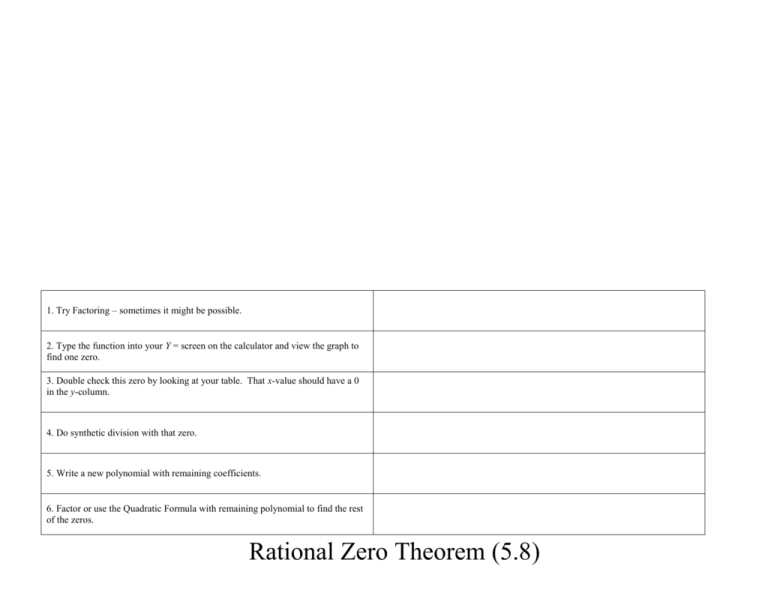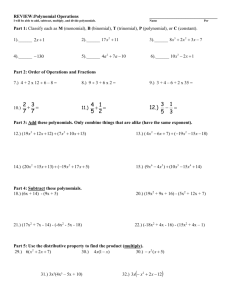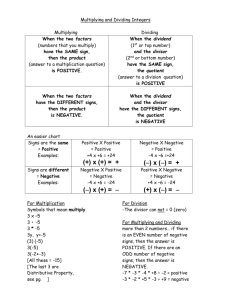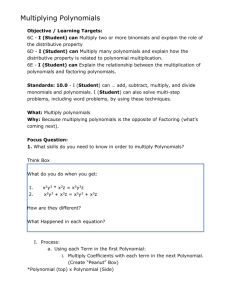Flip book
advertisement

1. Try Factoring – sometimes it might be possible. 2. Type the function into your Y = screen on the calculator and view the graph to find one zero. 3. Double check this zero by looking at your table. That x-value should have a 0 in the y-column. 4. Do synthetic division with that zero. 5. Write a new polynomial with remaining coefficients. 6. Factor or use the Quadratic Formula with remaining polynomial to find the rest of the zeros. Rational Zero Theorem (5.8) 1. Determine all of the solutions of the function. (Don’t forget that imaginary roots always come in pairs) 2. Write the solutions as factors. 3. Multiply all factors by using either the Box Method or Double Distribute. 4. Write your final answer as f(x) = … Writing a Polynomial Function (5.7) Property Definition Product of Powers xa xb = xa + b Quotient of Powers xa x a b , x 0 b x Negative Exponent xa 1 1 and a x a , x 0 a x x Power of a Power (xa)b = xa •b Power of a Product (xy)a = xaya a Power of a Quotient Zero Power x xa , y 0, and ya y x y a a ya y or a , x 0, y 0 x x x0 = 1, x ≠ 0 Properties of Exponents (5.1) Example 1. Rewrite the problem. 2. Divide the first term of the dividend by the first term of the divisor and write that answer on the line. 3. Multiply that answer by the first term of the divisor and write your answer below the dividend. Also multiply that answer by the second term of the divisor and write your answer. 4. Subtract and bring down the next term from the dividend. 5. Divide the first term of this new dividend by the first term in the divisor and write that answer on the line. 6. Multiply that answer by the first term of the divisor and write your answer below the dividend. Also multiply that answer by the second term of the divisor and write your answer. 7. Subract. 8. Your answer is on the line (at the top of the problem). If you have a remainder, write it as a fraction at the end of your answer. The denominator of that fraction is the divisor. Dividing Polynomials using Long Division (5.2) Degrees of polynomials Rules to be a polynomial Constant – Degree 0 Linear – Degree 1 Quadratic – Degree 2 Cubic – Degree 3 Quartic – Degree 4 Degree n – higher degree Adding Polynomials No: 1. 2. 3. square roots of variables fractional exponents variables in the denominator of any fraction Subtracting Polynomials 1. Distribute the negative to the second polynomial. 1. Combine like terms. 2. Combine like terms. Distributing Multiplying Polynomials 1. Determine whether you will need to distribute (one term times a polynomial) OR Box method (two or more terms times a polynomial). *If multiplying a binomial by a binomial, make a 2x2 box, if a trinomial times a binomial, make a 3x2 box 2. Combine like terms if needed. Add/Subtract/Multiply Polynomials (5.1) Box Method A Relative Maximum is a point on the graph of a function where no other nearby points have a greater ycoordinate. A Relative Minimum is a point on the graph of a function where no other nearby points have a lesser y-coordinate. Extrema are the maximum and minimum values of a function. These points are usually referred to as turning points. It is also another name for relative maximums and minimums. The graph of a polynomial function of degree n has at most n – 1 turning points. Find Extrema on Calculator: 1. Enter the equation into y =. 2. Hit 2nd Calc. 3. Choose 3: minimum or 4: maximum. 4. Put the curser to the left of min/max, hit enter. 5. Put the curser to the right of min/max, hit enter. 6. Hit enter. Analyze the graph Find the relative extrema of: Relative Minimum: Relative Maximum: Describe the end behavior Analyzing Graphs (5.3 & 5.4) Equations of higher degree where the first term exponent is double the second term exponent Decide what u represents (hint: Look at the second term exponent) Rewrite the equation as: au2 + bu + c = 0 Factor the equation using product sum or slide and divide Substitute the x’s back in for the u. Quadratic Form (5.5) The binomial x – r is a factor of the polynomial P(x) if an d only if P(r) = 0 Used to factor polynomials with higher degrees that cannot be written in quadratic form 1. Perform synthetic division with the given factor. 2. Factor the remaining polynomial using product sum or slide and divide The Factor Theorem (5.6) 1. Write the coefficients of the dividend so that the degrees of the terms are in descending order. Write the constant r of the divisor x – r in the box. Example: Divide x4 + 3x3 –x2 + 8 by x – 1 2. Bring the first coefficient down and multiply it by r. Write the product under the second coefficient. 3. Add the product and the second coefficient. 4. Repeat Steps 2 and 3 until you reach a sum in the last column. 5. The numbers along the bottom row are the coefficients of the quotient. The power of the first term is one less than the degree of the dividend. The final number is the remainder. Answer: Synthetic Division (5.2) Sum of two cubes a3 + b3 = (a + b)(a2 – ab + b2) 1. Factor out the GCF 2. Write each term as a perfect cube 3. Identify the given variables, a, b, a2, b2, ab 4. Substitute the values from step 3 into the formula Difference of two cubes a3 – b3 = (a – b)(a2 + ab + b2) 1. Factor out the GCF 2. Write each term as a perfect cube 3. Identify the given variables, a, b, a2, b2, ab 4. Substitute the values from step 3 into the formula Sum & Difference of Cubes (5.5) 1. Write the expression in degree descending order. 2. Factor out a GCF, if necessary. 3. Group the first two terms together in parentheses and the second two terms together in parentheses. 4. Factor out the GCF from each group. 5. Once the GCF is factored out, the items in the parentheses should be identical. Write that here → 6. What’s left over should be written here and your answer from step 5 should be written next to it. Factoring by Grouping (5.5)









